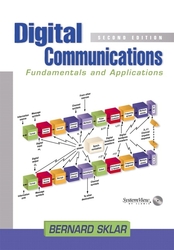Understanding Information Transmission
暫譯: 理解資訊傳輸
John B. Anderson, Rolf Johannesson
- 出版商: Wiley
- 出版日期: 2005-01-01
- 售價: $3,310
- 貴賓價: 9.5 折 $3,145
- 語言: 英文
- 頁數: 322
- 裝訂: Paperback
- ISBN: 0471679100
- ISBN-13: 9780471679103
海外代購書籍(需單獨結帳)
買這商品的人也買了...
-
 SQL Server 2000 管理實務
SQL Server 2000 管理實務$680$537 -
 sed & awk 程式設計 (sed & awk, 2/e)
sed & awk 程式設計 (sed & awk, 2/e)$680$537 -
 AutoCAD 2002 2D 實力養成暨評量
AutoCAD 2002 2D 實力養成暨評量$350$277 -
 SQL 語法查詢百科 (SQL Fundamentals, 2/e)
SQL 語法查詢百科 (SQL Fundamentals, 2/e)$720$569 -
 專業 ADO.NET 程式設計 (Professional ADO.NET)
專業 ADO.NET 程式設計 (Professional ADO.NET)$720$569 -
 ASP.NET 資料庫程式設計─使用 C#
ASP.NET 資料庫程式設計─使用 C#$550$435 -
 C# Primer Plus 中文版 (C# Primer Plus)
C# Primer Plus 中文版 (C# Primer Plus)$680$537 -
 C# 範例精要解析
C# 範例精要解析$690$545 -
 人月神話:軟體專案管理之道 (20 週年紀念版)(The Mythical Man-Month: Essays on Software Engineering, Anniversary Edition, 2/e)
人月神話:軟體專案管理之道 (20 週年紀念版)(The Mythical Man-Month: Essays on Software Engineering, Anniversary Edition, 2/e)$480$379 -
 建構嵌入式 Linux 系統
建構嵌入式 Linux 系統$780$616 -
 ASP.NET 徹底研究進階技巧─高階技巧與控制項實作
ASP.NET 徹底研究進階技巧─高階技巧與控制項實作$650$507 -
 XOOPS 2 大補帖-模組與佈景主題大全
XOOPS 2 大補帖-模組與佈景主題大全$460$391 -
 Linux iptables 技術實務─防火牆、頻寬管理、連線管制
Linux iptables 技術實務─防火牆、頻寬管理、連線管制$620$490 -
 Java 2 全方位學習(J2SE 5.0 增修版)
Java 2 全方位學習(J2SE 5.0 增修版)$750$593 -
 PC DIY 2006 BIOS 密技王─超頻加速、優化調校、防毒防駭
PC DIY 2006 BIOS 密技王─超頻加速、優化調校、防毒防駭$350$277 -
 打造個人作業系統 Linux 0.01 核心編譯與系統開發
打造個人作業系統 Linux 0.01 核心編譯與系統開發$550$435 -
 計算機網路實驗以 NS2 模擬工具實作
計算機網路實驗以 NS2 模擬工具實作$450$428 -
 企業級 Linux 系統管理寶典
企業級 Linux 系統管理寶典$750$638 -
 Fedora Core 4 Linux 實務應用 DVD 版
Fedora Core 4 Linux 實務應用 DVD 版$650$514 -
 Linux 架站實務 2006-MIS、規劃、架設、管理、防毒
Linux 架站實務 2006-MIS、規劃、架設、管理、防毒$650$514 -
 精通 Spring Framework
精通 Spring Framework$580$452 -
 深入淺出 Java 程式設計, 2/e (Head First Java, 2/e)
深入淺出 Java 程式設計, 2/e (Head First Java, 2/e)$880$695 -
 BIOS Inside:BIOS 研發技術剖析, 2/e
BIOS Inside:BIOS 研發技術剖析, 2/e$620$490 -
 Linux Kernel 完全剖析
Linux Kernel 完全剖析$750$585 -
 物件導向開發實踐之路 C# 版
物件導向開發實踐之路 C# 版$680$537
商品描述
Description:
Understanding Information Transmission is an introduction to the field of information engineering targeted at Information Technology students. It spans the nature, storage, transmission, networking, and protection of information. A special feature of the book is its treatment of the spectacular history of information engineering and its social effects on all of us. As information transmission has emerged as one of the hottest topics in arenas ranging from mass media to research and development, this book will be of broad general interest to anyone interested in the progress of communications technology.
Table of Contents:
1. Introduction.
First Ideas and Some History.1.1 What is Communication?
1.2 Why Digital Communication?
1.3 Some History.
1.4 Conclusions.
Bibliography.
2. Mathematical Methods of Information Transmission.
Why Sinusoids?2.1 Linear, Time-Invariant (LTI) Systems.
2.2 On the Importance of Being Sinusoidal.
2.3 The Fourier Transform.
2.4 What is Bandwidth?
2.5 Discrete-time Systems.
2.6 Conclusions.
Bibliography.
Problems.
3. Information Sources.
What is Out There to be Sent?3.1 What is Text?
3.2 What is Speech?
3.3 What is Music?
3.4 What is an Image?
3.5 What is Video?
3.6 Conclusion.
Bibliography.
Problems.
4. Transmission Methods.
How is Information Sent?4.1 Communication Channels.
4.2 Analog Modulation.
4.3 Digital Modulation.
4.4 FM Stereo, Television and a Little About Electronics.
4.5 Conclusions.
Bibliography.
Problems.
5. Information Theory and Cooling.
What did Shannon Promise?5.1 Information Theory—a Primer.
5.2 Methods of Source Coding.
5.3 Methods of Channel Coding.
5.4 Trellis Coded Modulation.
5.5 Conclusions.
Bibliography.
Problems.
6. Cryptology.
FUBSWRORJB??6.1 Fundamentals of Cryptosystems.
6.2 Caesar and Vigenère Ciphers.
6.3 The Vernam Cipher and Perfect Secrecy.
6.4 Stream Ciphers.
6.5 Block Ciphers.
6.6 Cryptomachines During World War II.
6.7 Two-key Cryptography.
6.8 Conclusion.
Bibliography.
Problems.
7. Communication Networks.
Let’s get Connected.7.1 An Overview of Information Networks.
7.2 Circuit Switching: The Telephone Net.
7.3 Mobile Telephony.
7.4 The Internet.
Bibliography.
Appendix A. Complex Numbers.
Appendix B. Sinusoids and Circuit Theory.
Appendix C. Probability Theory—a Primer.
Index.
About the Authors.
商品描述(中文翻譯)
**描述:**
《理解資訊傳輸》是一本針對資訊科技學生的資訊工程領域入門書籍。它涵蓋了資訊的本質、儲存、傳輸、網路和保護。這本書的一個特別之處在於它對資訊工程壯麗歷史及其對我們所有人的社會影響的探討。隨著資訊傳輸成為從大眾媒體到研究與開發等領域中最熱門的話題之一,這本書將對任何對通訊技術進展感興趣的人具有廣泛的吸引力。
**目錄:**
1. 引言。
首先的想法和一些歷史。
1.1 什麼是通訊?
1.2 為什麼選擇數位通訊?
1.3 一些歷史。
1.4 結論。
參考文獻。
2. 資訊傳輸的數學方法。
為什麼選擇正弦波?
2.1 線性時不變(LTI)系統。
2.2 正弦波的重要性。
2.3 傅立葉變換。
2.4 什麼是頻寬?
2.5 離散時間系統。
2.6 結論。
參考文獻。
問題。
3. 資訊來源。
有什麼可以傳送的?
3.1 什麼是文本?
3.2 什麼是語音?
3.3 什麼是音樂?
3.4 什麼是影像?
3.5 什麼是視頻?
3.6 結論。
參考文獻。
問題。
4. 傳輸方法。
資訊是如何傳送的?
4.1 通訊通道。
4.2 類比調變。
4.3 數位調變。
4.4 FM立體聲、電視及一些電子學知識。
4.5 結論。
參考文獻。
問題。
5. 資訊理論與冷卻。
香農承諾了什麼?
5.1 資訊理論—入門。
5.2 資源編碼的方法。
5.3 通道編碼的方法。
5.4 網格編碼調變。
5.5 結論。
參考文獻。
問題。
6. 密碼學。
FUBSWRORJB??
6.1 密碼系統的基本原理。
6.2 凱薩與維吉尼亞密碼。
6.3 維納密碼與完美保密。
6.4 流密碼。
6.5 區塊密碼。
6.6 第二次世界大戰期間的密碼機。
6.7 雙鑰密碼學。
6.8 結論。
參考文獻。
問題。
7. 通訊網路。
讓我們連接起來。
7.1 資訊網路概述。
7.2 電路交換:電話網。
7.3 行動電話。
7.4 網際網路。
參考文獻。
附錄A. 複數。
附錄B. 正弦波與電路理論。
附錄C. 機率論—入門。
索引。
關於作者。






























